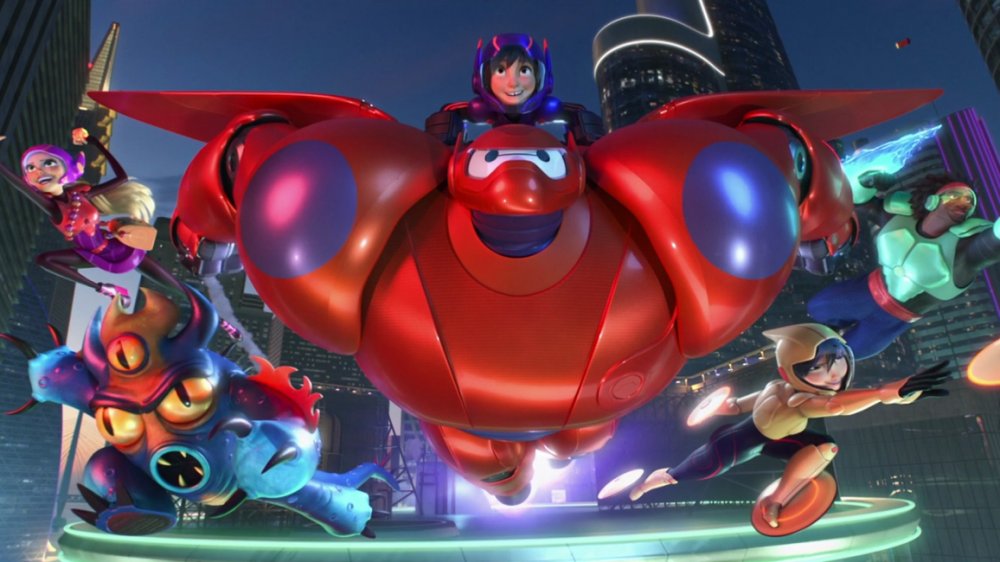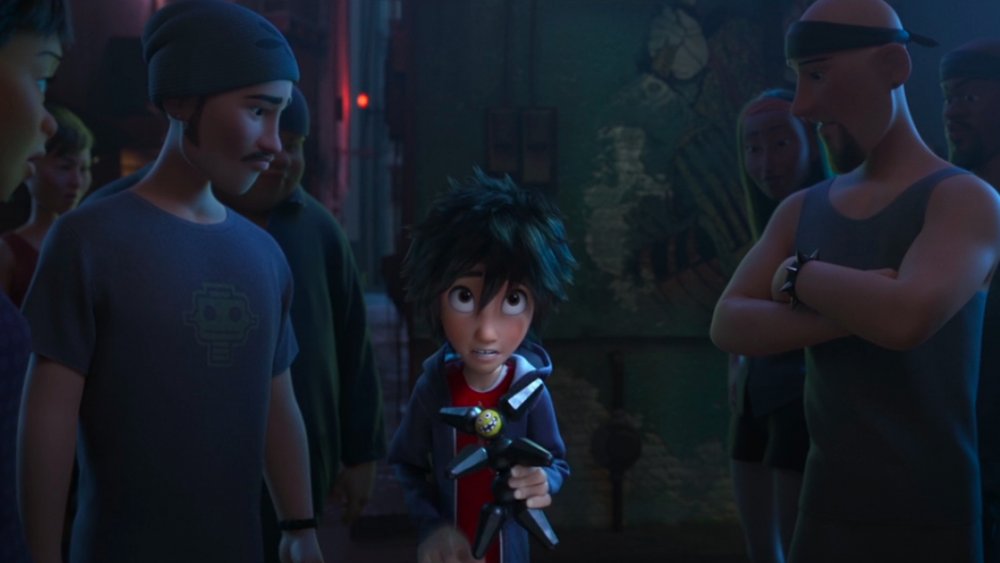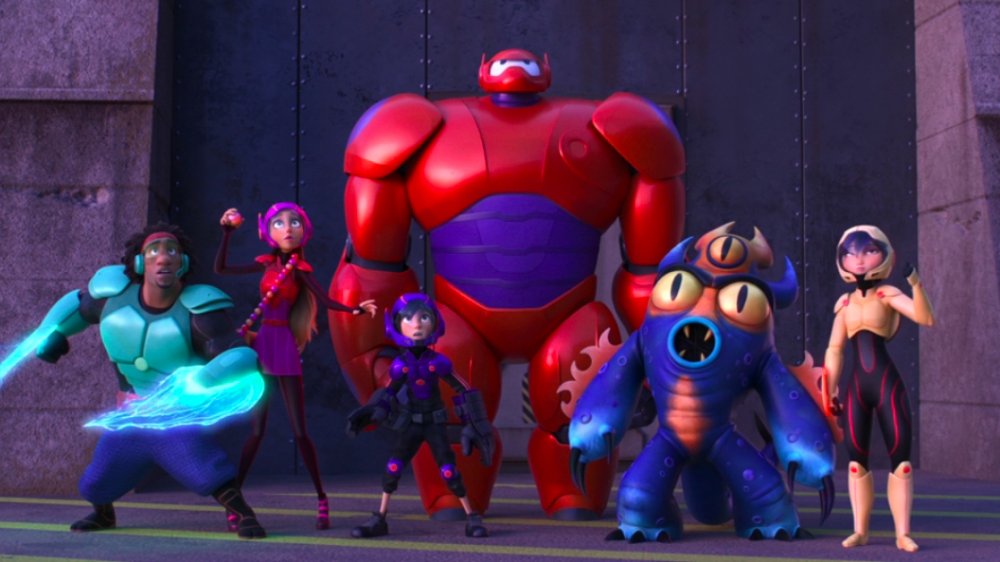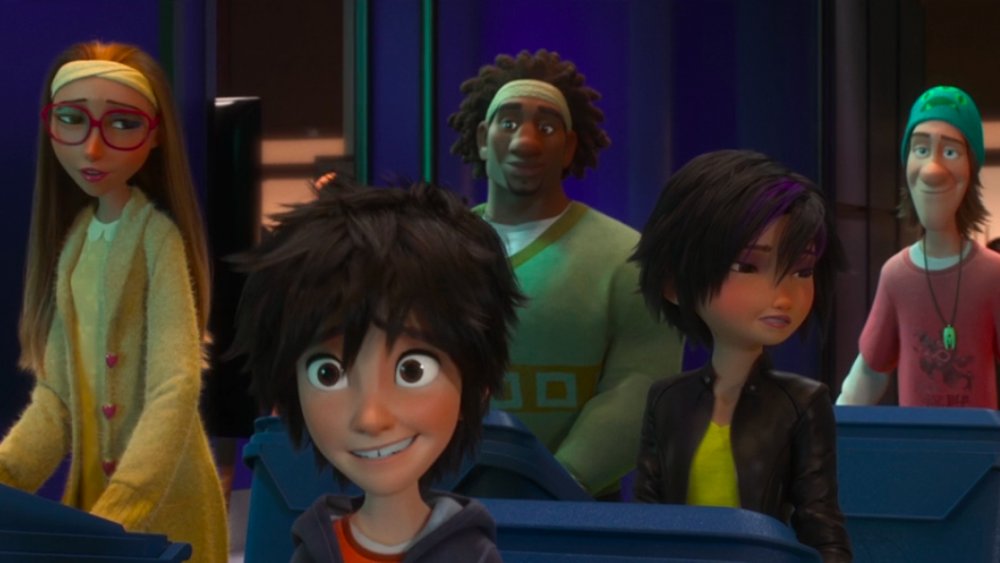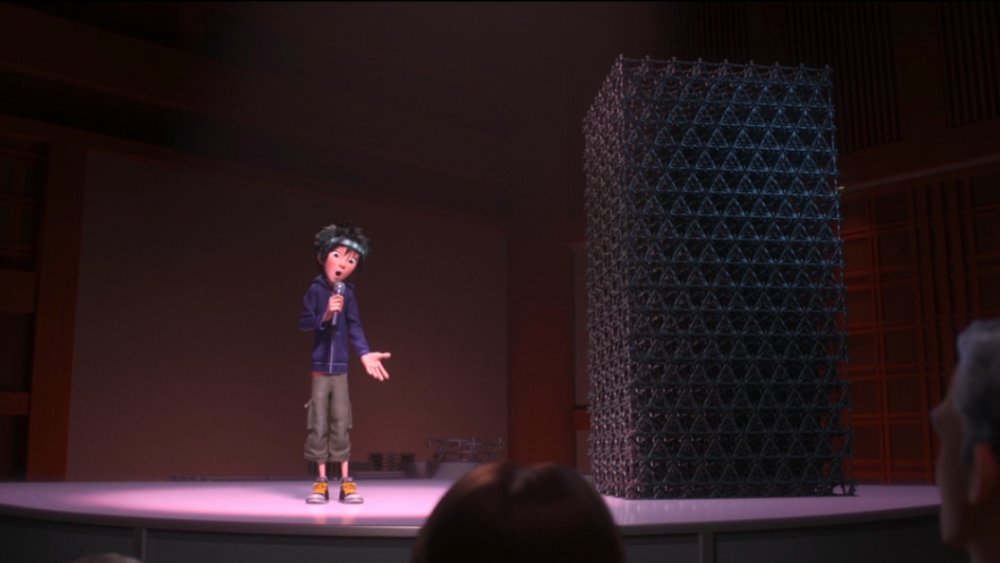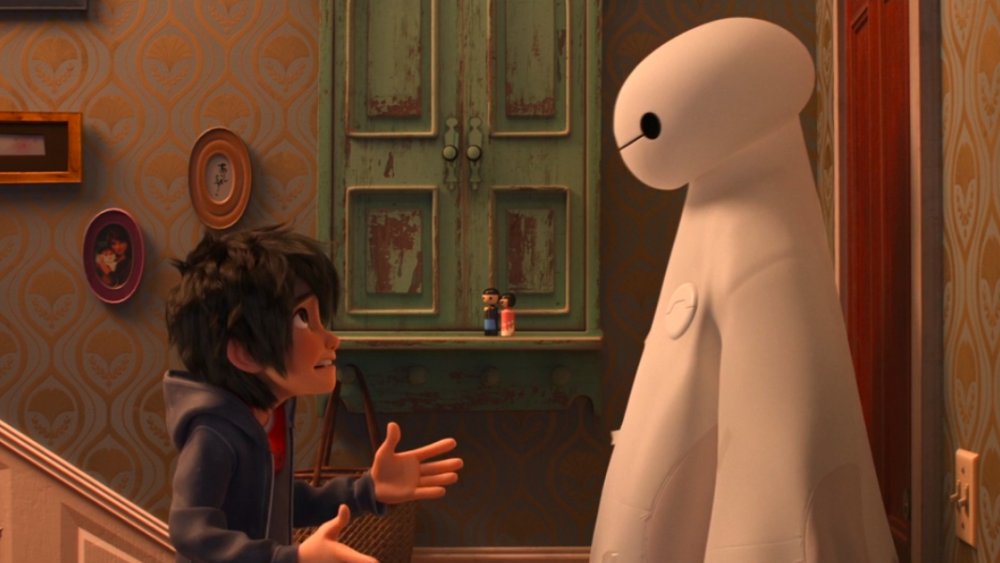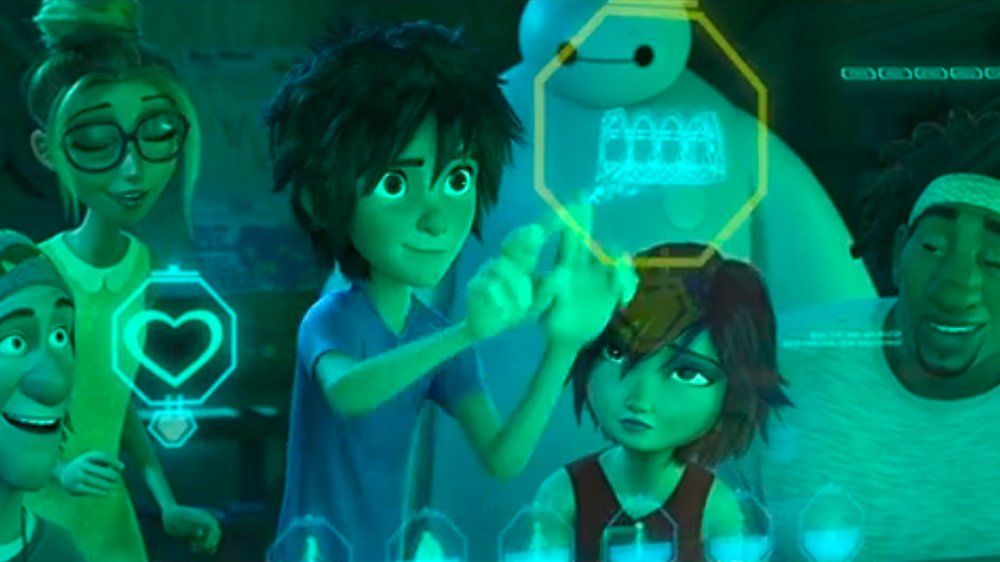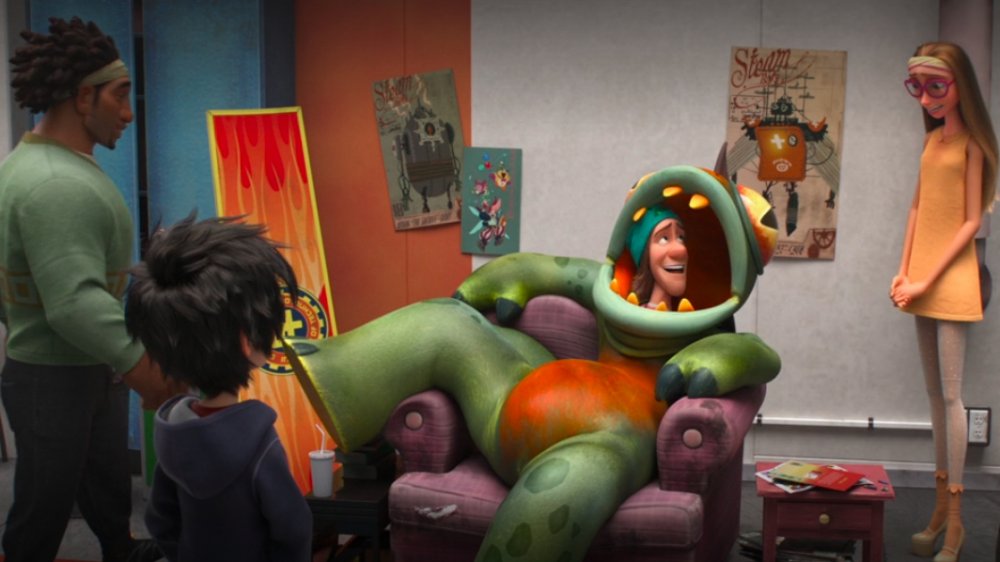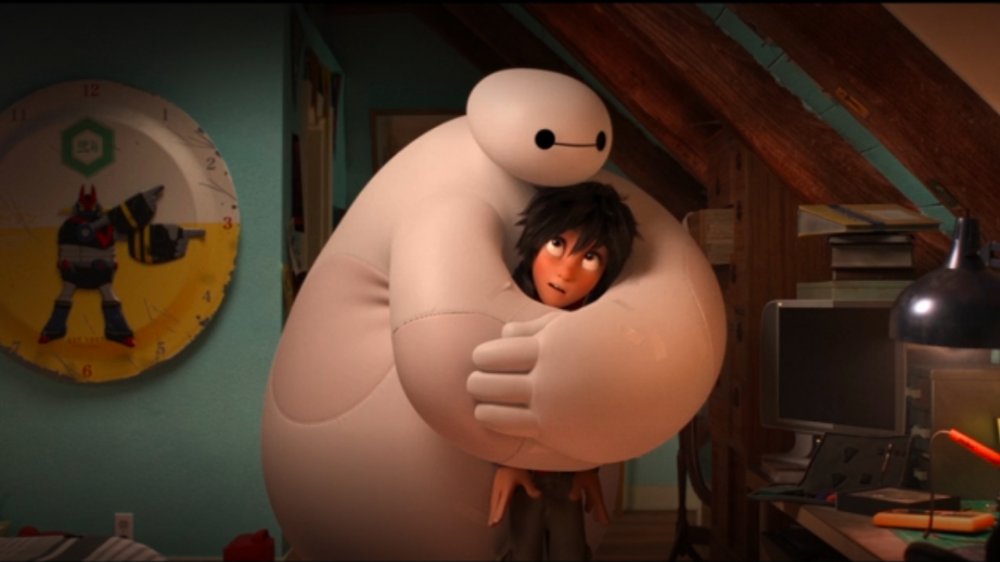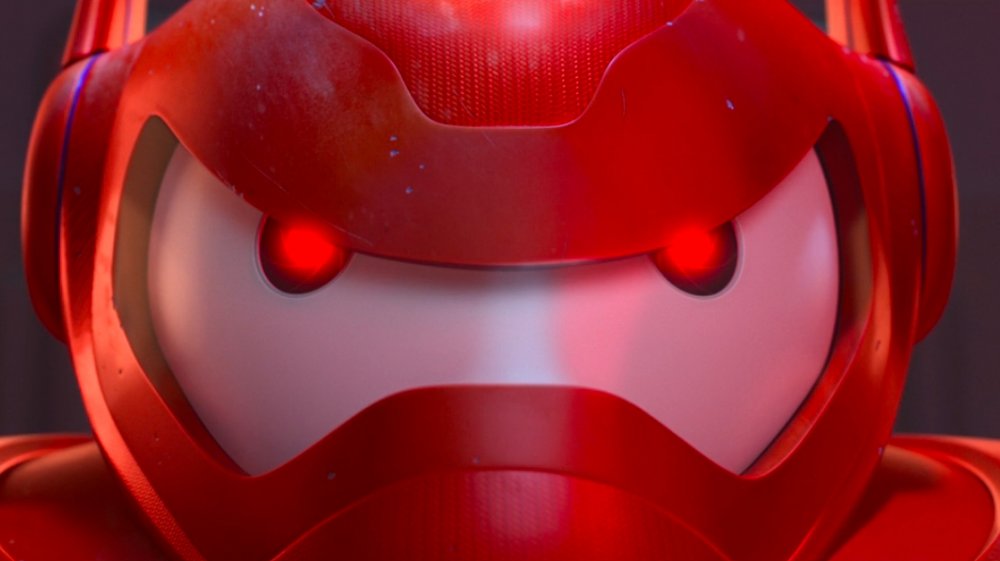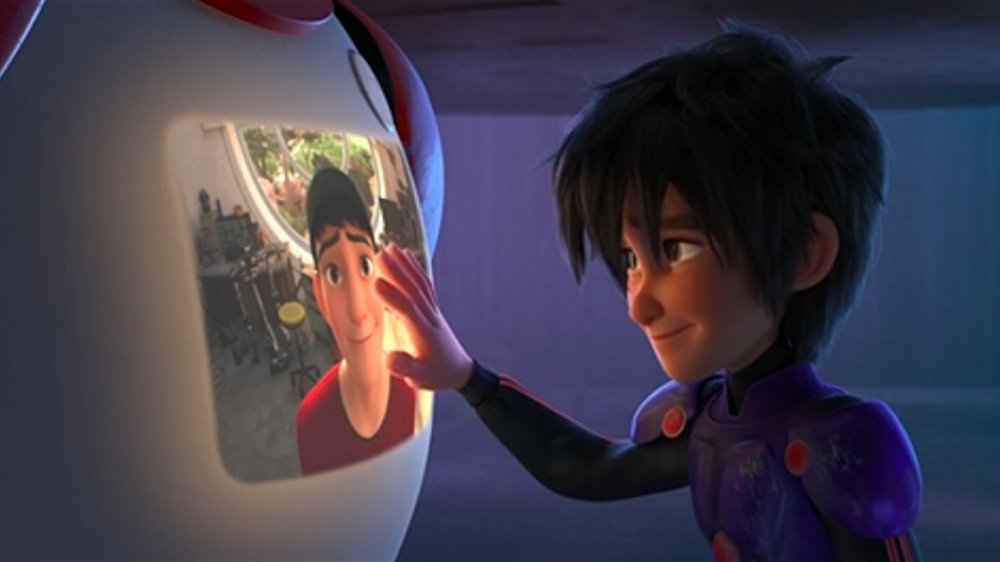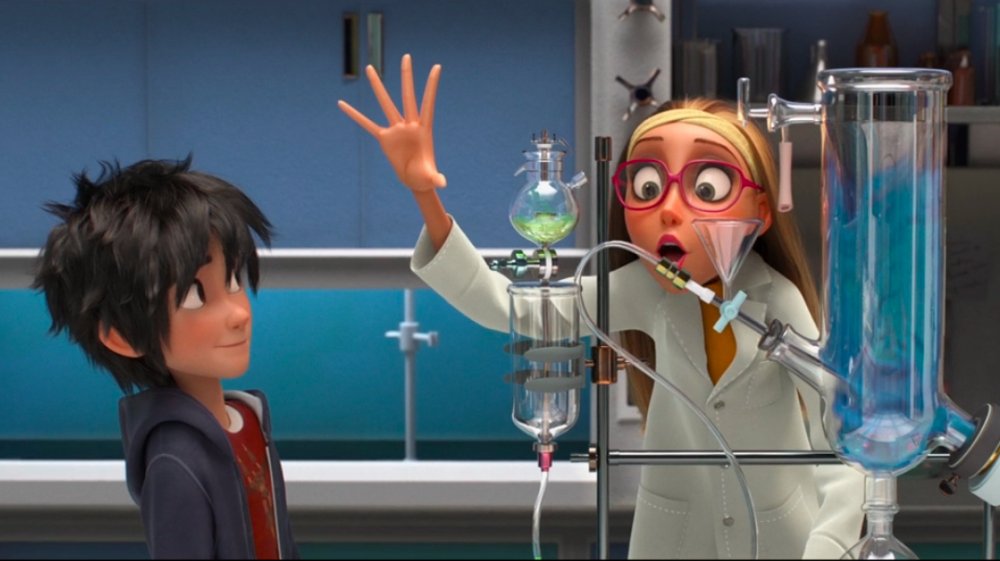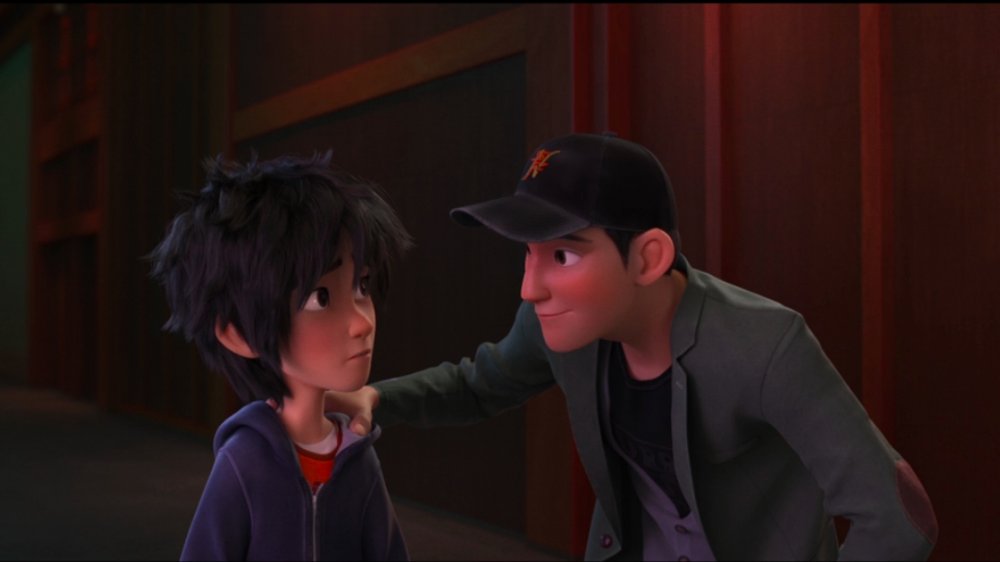Things Only Adults Notice In Big Hero 6
It's hard to remember a time when the Marvel Cinematic Universe wasn't dominating the box office every year with new, exciting superhero adventures based on beloved comic book characters. Yet in the midst of the MCU's Phase Two, right as the franchise was really hitting its stride with films like Captain America: The Winter Soldier and Guardians of the Galaxy, another Marvel film arrived in theaters which had no ties to the broader MCU, yet it could easily stand shoulder to shoulder with any of the franchise's most entertaining entries.
Based on the obscure Marvel comic Sunfire and Big Hero 6, Disney's animated superhero film Big Hero 6 follows 14-year-old robotics prodigy Hiro Hamada, who winds up becoming the leader of a science-powered superhero team after his world-changing invention is stolen by a mysterious masked villain. It's a moving tale of friendship, teamwork, and the importance of a solid STEM education, and just because it's aimed at a younger audience than the live-action films that make up the MCU, that doesn't mean there's not plenty in the film for adults to appreciate, enjoy, and occasionally question. Below, we dig into a few elements of Big Hero 6 that young kids may not even notice but will give adults plenty to think about.
Hiro is a total grifter in Big Hero 6
At the beginning of Big Hero 6, we meet young protagonist Hiro when he enters a bot fight — an underground gambling ring where competitors pit their homemade fighting robots against one another, and make or lose money based on the outcomes of the fights. Hiro is small, and his robot looks pathetically childish in everything from its blunt appendages to the goofy expression painted on its face. Hiro loses his first fight immediately, but he begs his opponent for a second chance. Eager to swindle Hiro out of even more money, his opponent agrees ... and watches as his previously undefeated bot is promptly demolished by Hiro's creation.
Even kids will notice that Hiro's demeanor changes on his second round in the bot fight, from nervous and hesitant to confident and composed, making it clear that Hiro was actually well-prepared for the fight and that the first round was simply a ruse. However, adults will pick up even more on the way he downplays his abilities at first. The high voice, the hunched shoulders, the crumpled up wad of cash as opposed to the slick roll he produces in the second round are all calculated choices Hiro makes to present himself as incapable and non-threatening. He knows exactly what to do in order to worsen his odds in the fight, driving up his ultimate take when he wins. Kids may realize Hiro tricked the gamblers, but adults will recognize the skills of an established con artist who's definitely done this before.
We never learn half of the characters' real names
Kids are so used to cartoon characters with weird names that monikers like Wasabi, Go Go, and Honey Lemon may not even strike them as remotely odd. This could make it easy for them to miss the line where Hiro asks about their names, and his older brother, Tadashi, explains that most of his friends at the San Fransokyo Institute of Technology go by nicknames given to them by Fred. However, we never learn what any of the characters' real names are, since they call each other exclusively by their made-up monikers throughout the entire film.
We also never receive much backstory on where the nicknames came from. Wasabi says he spilled wasabi on his shirt once, which led to his new name, but that's the most explanation we ever get about any of them. We can infer that Go Go's name stems from her speedster tendencies. Even before she developed her wheel-tipped superhero suit, she was working on an electromagnetic suspension bike, which decreased resistance in order to enable her to ride faster ("But not fast enough," she grumbles when Hiro meets her). Honey Lemon's name is the biggest mystery. We're left to speculate about whether it is a nod to her soothing personality, her favorite type of tea, a reference to some sort of chemistry experiment she conducted using common kitchen ingredients, or something else entirely unexpected.
The lab crew is shattering problematic tropes
Kids are well aware that superhero movies, along with the comics they're often based on, are typically filled with noble and inspiring characters. However, they may be less tuned in to the problematic tropes and stereotypes often associated with certain types of characters, such as the Scary Black Man or the Dumb Blonde, which means they're less likely to notice the many ways that Big Hero 6 subverts the archetypes we'd typically expect to see in a superhero movie.
Wasabi may fit the physical description of the Scary Black Man trope, but in Big Hero 6, he's gentle, nervous, meticulous, and brilliant — about the furthest thing from "scary" that any character in the film (save, perhaps, Baymax) can possibly be. Honey Lemon is blonde, bubbly, and extremely feminine, all characteristics that would traditionally tend to slot her into the role of Dumb Blonde. But she's also an accomplished scientist with a boundless enthusiasm for creating complex chemical compounds. Plus, in a superhero film landscape that was — especially in 2014 — overwhelmingly white and male, the Big Hero 6 team is made up almost entirely of women and people of color. The lone exception is the quintessential slacker Fred, yet even he bucks our expectations by also being a self-proclaimed "science enthusiast" who legitimately loves hanging out in what Hiro dubs the "nerd lab," just for fun.
Hiro's technology would cost a lot of jobs
In an attempt to come up with a stunning science project that will grant him admission to the San Fransokyo Institute of Technology (SFIT), Hiro invents "microbots," tiny robots that can be controlled by a headband-shaped neurotransmitter in order to perform nearly any task the wearer can conceive of. Hiro's demonstration of the microbots' capabilities is seriously impressive, as he shows how the microbots can work together to create complex structures, transport him around the room, and even wave to the audience as a giant hand, all with nothing more than a thought from Hiro.
"The applications of this tech are limitless," Hiro tells his captive audience, which includes local tech magnate Alistair Krei. "Construction! What used to take teams of people working by hand for months or years can now be accomplished by one person, and that's just the beginning."
This sounds great, until you think about the implications of the construction industry replacing nearly their entire workforce with robots. Thousands of jobs would be eliminated overnight, which would be a huge hit to the local and national economy. While investors and business owners like Krei would see a major increase in their profits, it would be at the cost of countless skilled laborers and their families, who would suddenly find their skills worthless. When Hiro says that construction is "just the beginning," it's presented optimistically, but in practice, what he's proposing could actually signal the beginning of the end.
Baymax with a low battery is super drunk
One of the main characters of Big Hero 6 is Baymax, an adorably squishy, robotic healthcare companion who was invented by Tadashi, and who spends most of the film attempting to care for Hiro following Tadashi's tragic death. After the two characters discover that someone has stolen Hiro's microbots and is replicating his technology, Baymax realizes that in all the excitement, his battery has drained to practically nothing, and it's up to Hiro to get the barely-powered robot back to his charging station in one piece.
During the hilarious sequence that ensues, Baymax stumbles around, slurs his speech, gets weirdly cuddly and uncoordinated, and generally acts like he's totally plastered. It's blatantly obvious to anyone past their mid-teen years, but little kids will totally miss that low-battery Baymax is portrayed exactly like someone who's had a few too many drinks. Kids will definitely know that Baymax is being silly, but they'll have no clue about the precise nature of the silliness that the Big Hero 6 writers and animators are channeling in that scene. That's in there solely for adults.
Hiro's garage setup in Big Hero 6 is seriously impressive
All superhero movies tend to require some hefty suspension of disbelief, and Big Hero 6 is no exception. Even if you have no trouble buying the awesome gadgetry that the students of San Fransokyo Institute of Technology have invented, or that Hiro managed to manufacture thousands upon thousands of microbots by himself in his garage in just a couple weeks, it may be a little hard to swallow that a 14-year-old kid would have such an advanced workshop in his garage.
Sure, Hiro's a genius and likely built or invented most of his gear himself, but even so, he's basically got Tony Stark's workshop set up in his house, complete with holographic, interactive computer monitor. While there may not be a huge difference in the cognitive capabilities between Iron Man and Hiro, there's one huge discrepancy between them that makes it a little unbelievable that their setups would appear so similar: money. Tony Stark is a billionaire, while Hiro is an orphaned kid who lives above a cafe. While he makes money from his bot fights and probably has some sort of inheritance from his parents, nothing about his living situation indicates that Hiro is sitting on top of a gigantic pile of cash. So how does he afford all of this amazing equipment that enables him to not only create his microbots but eventually outfit his entire team in their supersuits? Kids won't think to ask, but adults will always wonder.
Fred may be in some sort of 12-step program
Throughout Big Hero 6, Fred is a bit of an enigma. He's not a student at SFIT, yet he's somehow the school mascot. He spends all his time hanging out with scientists, yet he seems to have no real idea what science actually is. And he wears his underwear for six days straight, yet he's revealed to be the mind-blowingly rich son of Stan Lee. Despite Fred's proclivity for sharing his opinions on just about everything, we still get the impression that there's a lot we don't know about the lovable doofus, not because Fred is secretive, but because he just hasn't gotten around to telling us yet.
One intriguing glimpse into Fred's surprising layers comes at around the halfway point of the film, when Baymax asks the SFIT crew if anyone would like to share their feelings in order to help them process their grief over Tadashi's death. Fred volunteers to go first, and starts out by saying, "My name is Fred, and it has been 30 days since my last —"
We never learn what the end of that sentence was, but from the way Fred began, it sounds like he's no stranger to groups meant to help aid people in their recovery. We can only guess at what sort of addiction Fred is struggling with, and how long it's been part of his story, but we're proud of him for making it 30 days without ... something. And we hope he has the strength to permanently overcome ... whatever it is.
Big Hero 6 is the rare superhero movie that prioritizes mental health
Although superhero films occasionally tackle mental health issues, such as Iron Man 3's attempt to address Tony Stark's PTSD following the Battle of New York in The Avengers, it's rare to see one take a truly nuanced look at the link between mental and physical health. At the beginning of the Big Hero 6, when Baymax asks Hiro to rate his pain from one to ten, Hiro jokingly asks, "Physical or emotional?" However, throughout the film, Baymax actually prioritizes Hiro's mental health on an equal level with his physical health. As a matter of fact, Baymax's programming seems to view them as inextricably linked, and he continually comments on the physical readings he's getting that speak to Hiro's improved or worsened emotional state.
Tadashi didn't program Baymax with mental health caregiving techniques, but when Baymax realizes that the pain Hiro is dealing with is not physical but emotional, he downloads a database on personal loss. From that point on, all of Baymax's actions are in an effort to help Hiro process Tadashi's death in a healthy way, which he views as integral to his role as a healthcare companion. By taking the stand that it's impossible to provide comprehensive medical care without taking into account the patient's emotional well-being, Big Hero 6 ventures into territory that is frequently left untouched by superhero fare — especially in movies meant for kids — and shows us that sometimes, offering emotional support to someone in distress may be the most heroic thing we can do.
One of the themes is that vengeance isn't healthy
After learning that the explosion that killed Tadashi was caused by his mentor, Professor Callahan, as part of a scheme to steal Hiro's microbots, Hiro tosses aside Baymax's healthcare companion programming chip, leaving nothing but the combat chip in its place. Without Tadashi's programming to temper him, Baymax goes on a violent rampage after Callahan on Hiro's orders, barreling his way through everyone that gets in his path as he attempts to destroy the man who killed his creator. In their attempts to keep Baymax — and thus, Hiro — from doing something he can't take back, Fred, Wasabi, and Go Go all try to intervene, and they're nearly killed as a result. It's only once Honey Lemon restores Tadashi's chip that Baymax stops what he's doing and apologizes for hurting his friends.
Kids will recognize that the gentle, huggable Baymax turning into an unstoppable vengeance monster is upsetting, but they may not be able to articulate why. However, adults will recognize Hiro's grief-fueled self-destructive behavior in this scene, as he orders Baymax to lash out in a way that hurts the people he cares about in his quest for vengeance. Later, Baymax refuses to allow Hiro to reprogram him again to seek vengeance against Callahan, even though Hiro is sure it's what he wants. As a healthcare companion, Baymax recognizes that Hiro's thirst for vengeance is not healthy, no matter how much he desires it, and instead gives him what he really needs — an opportunity to heal.
Big Hero 6 shows us what healthy grief looks like
The second time Hiro attempts to override Baymax's healthcare companion programming in order to seek vengeance against Callahan, Baymax is ready for him, and he doesn't allow him to access his programming chip port. Instead, Baymax shows Hiro videos of his brother, Tadashi, working in his lab, which moves Hiro to tears. Baymax's sole directive the whole movie is to heal Hiro, and by reminding him of who his brother was and what he cared about, Hiro is finally forced to deal with his complex emotions around his brother's loss.
Conversely, Callahan shows the dangers of grief channeled into vengeance. He mirrors Hiro in many ways. He lost someone he loved in an event caused by someone he trusted and found himself consumed by grief. Like Hiro, Callahan's instinct was also to lash out and seek revenge against the people he blamed for his loved one's death, hoping to find solace in their pain. But unlike Hiro, Callahan didn't have a Baymax to help him deal with his emotions in a healthy way, and we see in the climax of the film that Callahan's quest for retribution nearly destroys him and everyone around him. Kids may not fully understand how Hiro and Callahan represent two sides of the same coin, but adults will recognize Big Hero 6's message that vengeance doesn't lead to healing, and that grief has to be felt in order to move on.
Science and compassion save the day in Big Hero 6
Many superhero movies feature brilliant scientists and kindhearted heroes, yet most still tend to boil down to the ability of the good guys to punch the bad guys into submission. However, in Big Hero 6, everything continually comes back not to powers or brute strength, but to the science of it all. Characters repeatedly use their scientific knowledge to get themselves out of sticky situations. Even after Hiro and his team all have their super suits with their abilities to slice through metal and blow fire, most of their strategies involve outwitting their opponents rather than out-hitting them.
What's more, unlike most Marvel and DC fare, and even unlike other family-friendly superhero staple The Incredibles, no bad guys are killed in Big Hero 6. Instead, both Callahan and the morally gray Alistair Krei are saved, and the only character who's lost at the end of the film is Baymax, in a heroic act of self-sacrifice. Kids may not pick up on how unique it is for a superhero movie to allow its antagonists to walk away injury free, but adults will see that the film's low body count is yet another example of Big Hero 6's philosophy that many times, the most heroic thing we can do is help others until they're satisfied with their care.
Hiro follows in his brother's footsteps
It's evident to young and adult audiences alike how much Hiro looks up to his brother Tadashi, which is why he's so devastated by Tadashi's loss. Kids may even be able to pick up on how Hiro changes throughout Big Hero 6 to be more like Tadashi, especially in how he remakes Baymax and takes over Tadashi's lab. But adults may be able to spot just how completely Hiro embraces his brother's path by the end of the film — not just outwardly, but inwardly.
Not only does Hiro literally move into the physical spaces that Tadashi once inhabited, but he also adopts Tadashi's way of thinking, particularly when it comes to problem-solving. At the beginning of the film, when Hiro is trying to come up with a project for the SFIT showcase, Tadashi tells him, "Shake things up. Use that big brain of yours to think your way out. Look for a new angle." In the climax of the film, Hiro repeats this advice practically verbatim to his team when they're being overwhelmed by Callahan's microbots. But more than anything, Hiro's transformation is evident by the end of the film in how he ultimately chooses to internalize and act upon his brother's last words: "Someone has to help."
